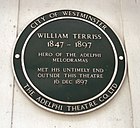William Terriss

William Terriss (20 February 1847 – 16 December 1897), born as William Charles James Lewin, was an English actor, known for his swashbuckling hero roles, such as Robin Hood, as well as parts in classic dramas and comedies. He was also a notable Shakespearean performer. He was the father of the Edwardian musical comedy star Ellaline Terriss and the film director Tom Terriss.
Athletic as a child, Terriss briefly joined the
In 1885, he met 24-year-old
Life and early career

Terriss was the third and youngest son of George Herbert Lewin, a
After brief stints in the
Over the next few years he established his acting career. His handsome presence, fine voice, friendly demeanour and gallant bearing made him one of Britain's most popular actors.
Peak years

In 1880 he joined
In December 1885 Terriss met 24-year-old Jessie Millward, with whom he starred as David Kingsley in the extraordinarily successful The Harbour Lights (by
In 1894 Terriss rejoined the Adelphi, earning even greater fame in melodrama.
Murder


On 16 December 1897, as he was entering the Adelphi Theatre through the stage door in Maiden Lane to prepare for the evening's performance of Secret Service, 50-year-old Terriss was stabbed to death by a deranged and disgruntled actor, Richard Archer Prince.[26] Terriss had helped the struggling younger actor to find work in various productions that he had a hand in.[26] However, Prince had, over the years, increasingly abused alcohol and become mentally unstable.[2] During the run of The Harbour Lights, in which Prince had a minor role, Terriss took offence to something that Prince said about him and had Prince dismissed.[2] Terriss, however, sent small sums of money to Prince via the Actors' Benevolent Fund, and continued to try to find him acting work.[2] By the end of 1897, Prince was destitute and desperate for work, but he had become unemployable.[2]
On 13 December 1897 Prince was forcibly ejected from the foyer of the Vaudeville Theatre, and he and Terriss were seen to argue the next night in Terriss's dressing room in the Adelphi Theatre. On the day of the murder Prince asked for money at the Fund's office, but was told that his request could not be considered that day.[2] He then apparently crossed the street and waited for Terriss, concealed in a doorway near the Adelphi's stage door.[5][16]
The murder became a sensation in the London press.
Memorials and references in popular culture

Terriss is buried in Brompton Cemetery, London.[29] A lifeboat house was built in 1898 on Eastbourne seafront in his memory. It still stands there with a memorial plaque. There is also a plaque on the wall by the stage door of the Adelphi Theatre recording his murder.[30] The Terriss Theatre in Rotherhithe, built in 1899, was named after him. It became the Rotherhithe Hippodrome in 1907 but was demolished in 1955; the site is now the Rotherhithe Free Church.[31]
A portrait of Terriss hangs in the stairwell of Denville Hall, the home for retired Actors and Actresses in
A fictionalised version of Terriss's murder, The Star of the Adelphi, was broadcast in 2002 on BBC Radio 4 as part of The Further Adventures of Sherlock Holmes.[32]
Ghost
Legend has it that Terriss's ghost haunts
References
- ^ Smythe, p. 2
- ^ doi:10.1093/ref:odnb/27144. (Subscription or UK public library membershiprequired.)
- ^ a b c "Terriss, William (William Charles James Lewin)", Who Was Who, A & C Black, 1920–2008, online edn, Oxford University Press, December 2007, accessed 8 January 2012
- ^ J. Comyns Carr, Some eminent Victorians: personal recollections in the world of art and letters (Duckworth & Co., 1908), pp. 3-4
- ^ a b c d e f g "The Terriss Tragedy", in New York Dramatic Mirror, 21 December 1897
- ^ Smythe, p. 29
- ^ London Evening Standard, 22 December 1887
- ^ Smythe, pp. 19–20
- ^ Smythe, pp. 27–30
- ^ Smythe, p. 31
- ^ Smythe, pp. 48–56
- ^ Smythe, pp. 56–68
- ^ Smythe, pp. 69–71
- ^ The New York Times, 26 April 1884, p. 21
- ^ Smythe, pp. 74 and 79
- ^ a b "Murder of William Terriss", Actors' Benevolent Fund website
- ^ ISBN 1-55783-516-0
- ^ Smythe, pp. 80–87
- ^ Smythe, pp. 87
- ^ Rowell, passim
- ^ "Obituary, Mr. Robert Courtneidge", The Times, 8 April 1939, p. 14
- ^ Smythe, pp. 98 and 112
- ^ Article referring to the Adelphi melodramas and Terriss
- ^ a b Smythe, chapter V
- ^ Smythe, p. 129
- ^ a b The New York Times, 17 December 1897, p. 3
- ^ The New York Times, 9 January 1898, p.16
- ^ Goodman, p. 70.
- ^ List of cemetery residents, Brompton Cemetery, accessed 11 January 2012
- ^ City of Westminster green plaques Archived 16 July 2012 at the Wayback Machine
- ^ "Rotherhithe Free Church", Geograph.org, accessed 20 January 2017
- ^ Prepolec, Charles. "The Further Adventures of Sherlock Holmes: Reviewed". The Singular Society of the Baker Street Dozen, 2002, accessed 31 March 2011
- ^ Watts, Peter. "City of the Dead", Timeout London, 25 October 2005]
- The History Channel, at 43:45 of the video, 5 November 2008
Sources
- Goodman, Jonathan. Acts of Murder. Foreword by ISBN 0-7088-3603-8.
- Rowell, George. William Terriss and Richard Prince: Two Characters in an Adelphi Melodrama (1987; London: Society for Theatre Research) ISBN 0-85430-042-2
- Smythe, Arthur J. The Life of William Terriss, Actor (Westminster: Archibald Constable, 1898). OCLC Number: 253652912
External links
- Information about Archer
- Final Performance, 2009 book about Terriss and his relationship with Jessie Millward
- great great granddaughter with Theatrical archive
